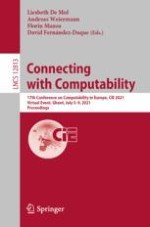This book constitutes the proceedings of the 17th Conference on Computability in Europe, CiE 2021, organized by the University of Ghent in July 2021. Due to COVID-19 pandemic the conference was held virtually.
The 48 full papers presented in this volume were carefully reviewed and selected from 50 submissions. CiE promotes the development of computability-related science, ranging over mathematics, computer science and applications in various natural and engineering sciences, such as physics and biology, as well as related fields, such as philosophy and history of computing. CiE 2021 had as its motto Connecting with Computability, a clear acknowledgement of the connecting and interdisciplinary nature of the conference series which is all the more important in a time where people are more than ever disconnected from one another due to the COVID-19 pandemic.
